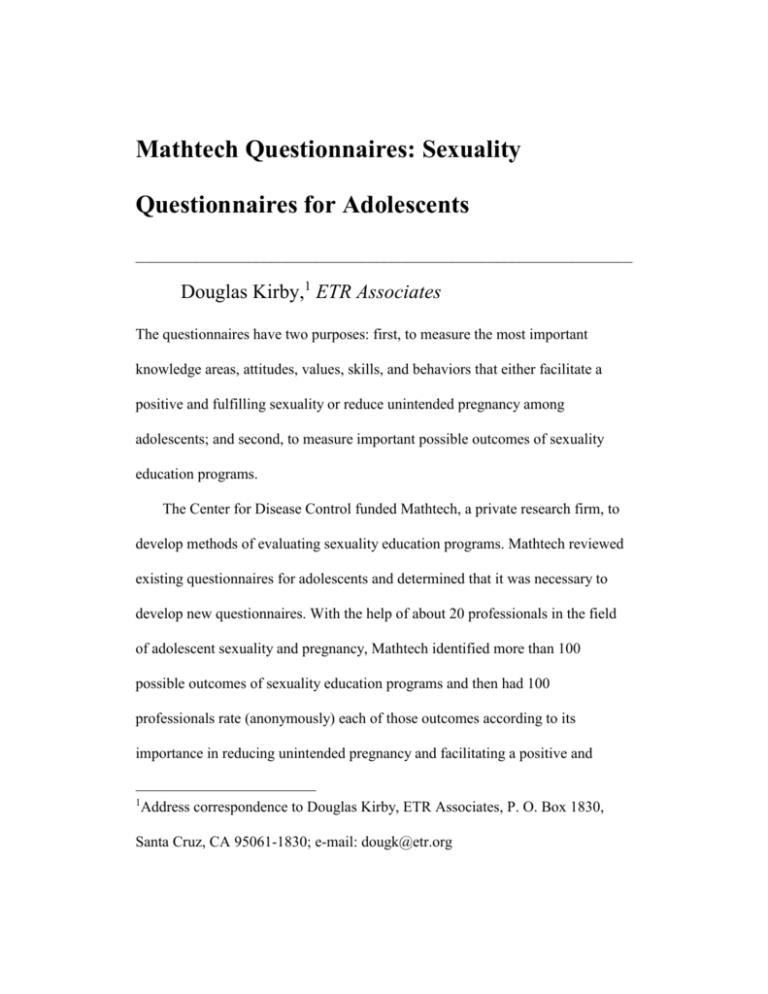
Mathtech Questionnaires: Sexuality
Questionnaires for Adolescents
__________________________________________________________________
Douglas Kirby,1 ETR Associates
The questionnaires have two purposes: first, to measure the most important
knowledge areas, attitudes, values, skills, and behaviors that either facilitate a
positive and fulfilling sexuality or reduce unintended pregnancy among
adolescents; and second, to measure important possible outcomes of sexuality
education programs.
The Center for Disease Control funded Mathtech, a private research firm, to
develop methods of evaluating sexuality education programs. Mathtech reviewed
existing questionnaires for adolescents and determined that it was necessary to
develop new questionnaires. With the help of about 20 professionals in the field
of adolescent sexuality and pregnancy, Mathtech identified more than 100
possible outcomes of sexuality education programs and then had 100
professionals rate (anonymously) each of those outcomes according to its
importance in reducing unintended pregnancy and facilitating a positive and
1
Address correspondence to Douglas Kirby, ETR Associates, P. O. Box 1830,
Santa Cruz, CA 95061-1830; e-mail: dougk@etr.org
fulfilling sexuality. Mathtech then calculated the mean ratings of those outcomes
and developed questionnaires to measure many of the most important outcomes.
The questionnaires, which measure these important outcomes, include the
Knowledge Test, the Attitude and Value Inventory, and the Behavior Inventory.
KNOWLEDGE TEST
Description
The Knowledge Test is a 34-item multiple-choice test. It includes questions in the
following areas: adolescent physical development, adolescent relationships,
adolescent sexual activity, adolescent pregnancy, adolescent marriage, the
probability of pregnancy, birth control, and sexually transmitted disease. It has
been used successfully with both junior and senior high school students.
To develop the questionnaires, we completed the following steps: (a)
generated between 5 and 20 items in each of the content areas that the 100
professionals indicated as important; (b) pretested the questionnaire with small
groups of adolescents and adults, and clarified many items; (c) administered the
questionnaire to 729 adolescents, analyzed their answers, removed items that were
too easy or too difficult, and also removed items not positively related to the
overall test score; (d) removed questions from content domains that had too many
questions; and (e) made numerous refinements following subsequent
administrations of the questionnaires and reviews by other professionals.
ATTITUDE AND VALUE INVENTORY
Description
The Attitude and Value Inventory includes 14 different scales, each consisting of
five 5-point Likert-type items. The responses include strongly disagree, disagree,
neutral, agree, strongly agree. The scales are identified in Table 1.
To develop the questionnaires, we completed the following steps: (a)
generated 5 to 10 items for each of the psychological outcomes rated important by
the 100 experts; (b) had the items reviewed by small groups of both adults and
adolescents who made suggestions for changes; (c) had two psychologists trained
in questionnaire design and scale construction examine each item for
unidimensionality and clarity; and (d) had more than 200 adolescents complete the
questionnaire, removing those items that had a correlation coefficient greater than
.30 with the Crowne-Marlowe (1964) Social Desirability Scale, that had the
lowest scale loadings on each scale, and that had mean scores near the minimum
or maximum possible score.
BEHAVIOR INVENTORY
Description
Many behaviors have at least three important components or aspects to them: the
skill with which the behavior is completed, the comfort experienced during that
behavior, and the frequency of that behavior. The Behavior Inventory measures
these three aspects of several kinds of behavior. The actual measures are identified
in Tables 2 and 3.
The questions measuring skills use 5-point scales with answers ranging from
almost always to almost never; those measuring comfort use 4-point scales
ranging from comfortable to very uncomfortable; those measuring sexual activity,
use of birth control, and frequency of communication ask how many times during
the previous month the respondent engaged in the specified activity.
It is important to realize that the questions measuring skill do not try to assess
skill in the classroom but, instead, measure the frequency with which respondents
actually use important skills in everyday life.
The panel of 100 experts rated most highly most of the skills, areas of
comfort, and behaviors for which we developed measures. We tried many
different ways of measuring skills and after a variety of attempts and pretests with
small groups of adolescents, we settled on the current approach in which we
identified key behaviors in various skills and simply asked what proportion of the
time respondents engage in those behaviors.
The scales measuring comfort and behaviors flowed directly from the
outcomes specified by the experts. We conducted minitests with both adults and
adolescents to determine for how many months they could accurately measure
their communication and sexual behavior. Nearly all adolescents could remember
their behavior for the previous month.
The entire inventory was reviewed by psychologists who examined each item
for clarity, unidimensionality, and comprehensibility. More than 100 adolescents
completed the questionnaire; their responses indicated that most data were
reliable.
Because of the great sensitivity of these questions, the researcher should (a)
get appropriate approval to administer the questionnaire, (b) emphasize to the
students that completing the questionnaire is voluntary, and (c) take every
reasonable measure to assure that the answers remain absolutely anonymous.
Remember, if students learn that some particular girl (or boy) has experienced (or
not experienced) sex, that person’s reputation can be greatly damaged.








